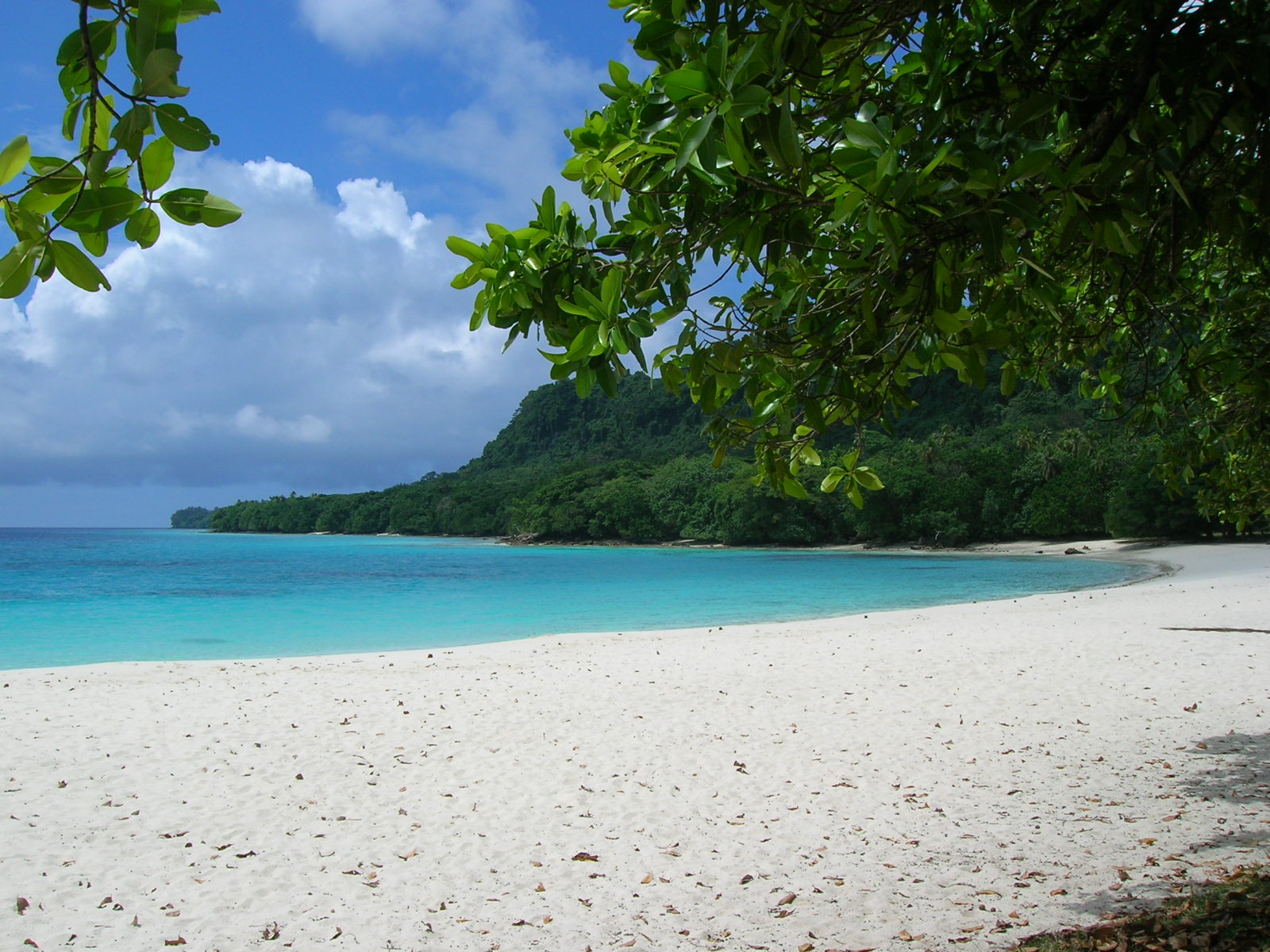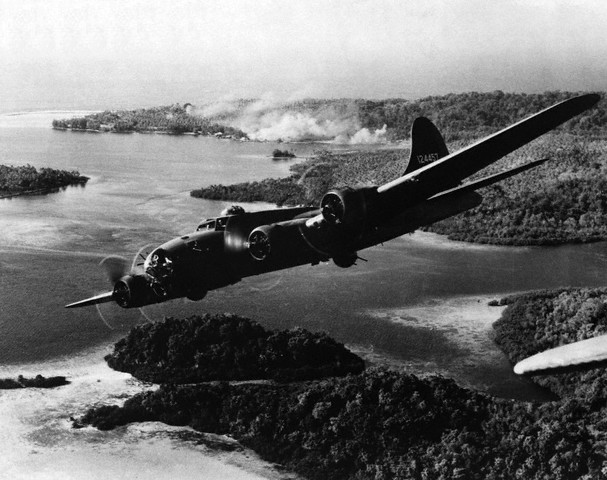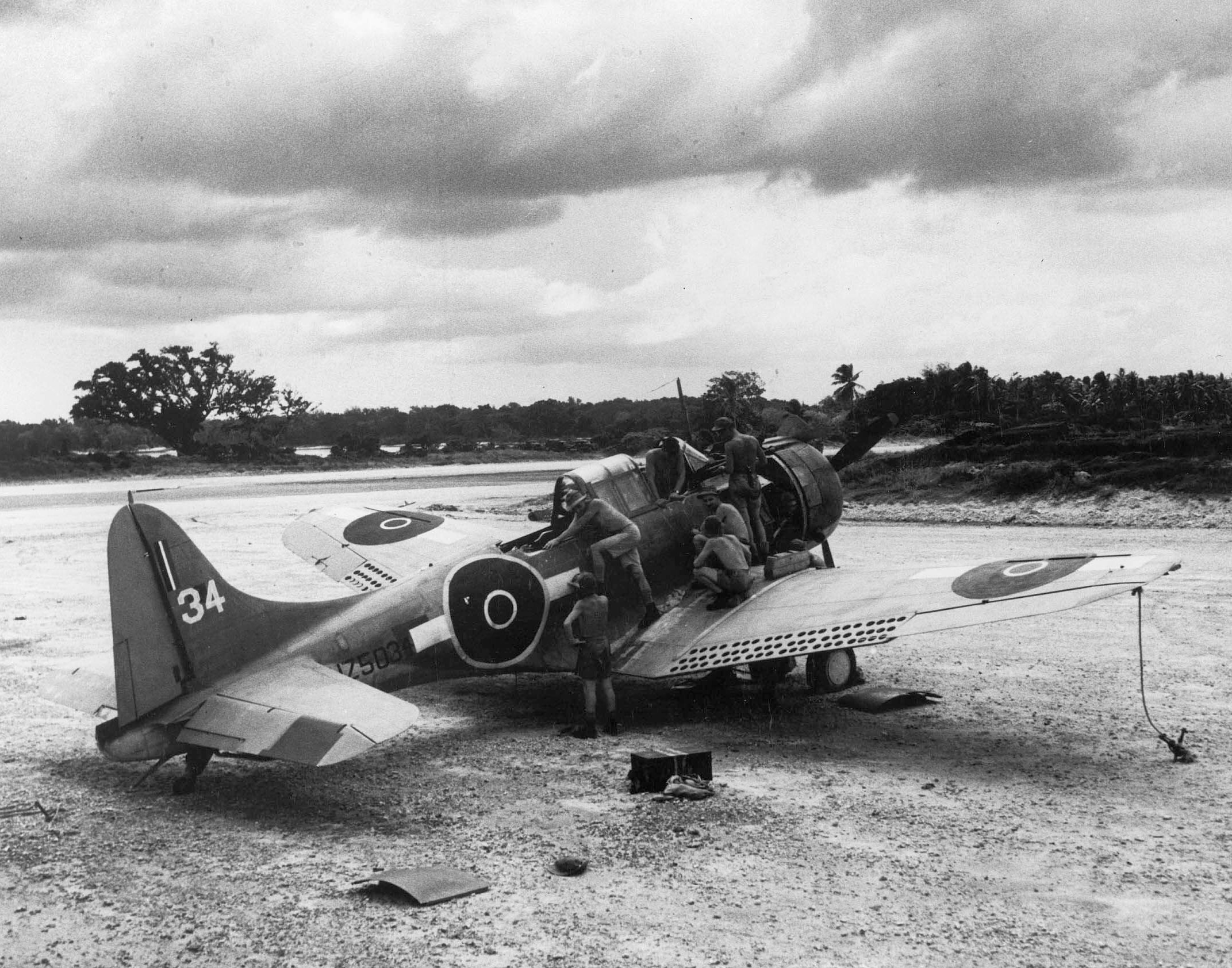|
Luganville Seaplane Base
Luganville Seaplane Base is a former World War II seaplane base in the Segond Channel between the islands of Espiritu Santo and Aore Island in the New Hebrides Islands at the Espiritu Santo Naval Base. History World War II The first bases on Espiritu Santo were established by the United States as defensive bases to guard the existing facility at Efate and to support the Solomon Islands Campaign, however its strategic location led to its expansion into one of the largest advance bases in the South Pacific. The 7th Naval Construction Battalion arrived on Santo on 11 August 1942 and began construction of more extensive air facilities to support the Guadalcanal Campaign. The 7th Battalion constructed a parking area, two pre-fabricated by nose hangars, warehouses, quonset huts and two seaplane ramps at Belchif Point on the Segond Channel between the Renee and Sarakata Rivers. The 57th Naval Construction Battalion later built two seaplane drydocks at the base. United States Navy uni ... [...More Info...] [...Related Items...] OR: [Wikipedia] [Google] [Baidu] |
Espiritu Santo
Espiritu Santo (, ; ) is the largest island in the nation of Vanuatu, with an area of and a population of around 40,000 according to the 2009 census. Geography The island belongs to the archipelago of the New Hebrides in the Pacific region of Melanesia. It is in the Sanma Province of Vanuatu. The town of Luganville, on Espiritu Santo's southeast coast, is Vanuatu's second-largest settlement and the provincial capital. Roads run north and west from Luganville, but most of the island is far from the limited road network. Around Espiritu Santo lie a number of small islands and islets; among them are: Dany Island, Araki, Elephant Island, Sakao, Lataroa, Lataro, Thion, Malohu, Malwepe, Malvapevu, Malparavu, Maltinerava, Oyster Island, Tangoa, and Bokissa. Vanuatu's highest peak is the 1879 metre (6165 foot) Mount Tabwemasana in west-central Espiritu Santo. History A Spanish expedition of three ships, led by Portuguese explorer Pedro Fernandes de Queirós, lande ... [...More Info...] [...Related Items...] OR: [Wikipedia] [Google] [Baidu] |
Airfields Of The United States Navy
An aerodrome (Commonwealth English) or airdrome (American English) is a location from which aircraft flight operations take place, regardless of whether they involve air cargo, passengers, or neither, and regardless of whether it is for public or private use. Aerodromes include small general aviation airfields, large commercial airports, and military air bases. The term ''airport'' may imply a certain stature (having satisfied certain certification criteria or regulatory requirements) that not all aerodromes may have achieved. That means that all airports are aerodromes, but not all aerodromes are airports. Usage of the term "aerodrome" remains more common in Ireland and Commonwealth nations, and is conversely almost unknown in American English, where the term "airport" is applied almost exclusively. A water aerodrome is an area of open water used regularly by seaplanes, floatplanes or amphibious aircraft for landing and taking off. In formal terminology, as defined by the ... [...More Info...] [...Related Items...] OR: [Wikipedia] [Google] [Baidu] |
Seaplane Bases
A seaplane is a powered fixed-wing aircraft capable of taking off and landing (alighting) on water.Gunston, "The Cambridge Aerospace Dictionary", 2009. Seaplanes are usually divided into two categories based on their technological characteristics: floatplanes and flying boats; the latter are generally far larger and can carry far more. Seaplanes that can also take off and land on airfields are in a subclass called amphibious aircraft, or amphibians. Seaplanes were sometimes called ''hydroplanes'', but currently this term applies instead to motor-powered watercraft that use the technique of hydrodynamic lift to skim the surface of water when running at speed. The use of seaplanes gradually tapered off after World War II, partially because of the investments in airports during the war but mainly because landplanes were less constrained by weather conditions that could result in sea states being too high to operate seaplanes while landplanes could continue to operate. In the 21 ... [...More Info...] [...Related Items...] OR: [Wikipedia] [Google] [Baidu] |
World War II Airfields In The Pacific Ocean Theater
In its most general sense, the term "world" refers to the totality of entities, to the whole of reality or to everything that is. The nature of the world has been conceptualized differently in different fields. Some conceptions see the world as unique while others talk of a "plurality of worlds". Some treat the world as one simple object while others analyze the world as a complex made up of many parts. In ''scientific cosmology'' the world or universe is commonly defined as " e totality of all space and time; all that is, has been, and will be". '' Theories of modality'', on the other hand, talk of possible worlds as complete and consistent ways how things could have been. ''Phenomenology'', starting from the horizon of co-given objects present in the periphery of every experience, defines the world as the biggest horizon or the "horizon of all horizons". In ''philosophy of mind'', the world is commonly contrasted with the mind as that which is represented by the mind. ''Th ... [...More Info...] [...Related Items...] OR: [Wikipedia] [Google] [Baidu] |
Seabees
United States Naval Construction Battalions, better known as the Navy Seabees, form the U.S. Naval Construction Force (NCF). The Seabee nickname is a heterograph of the initial letters "CB" from the words "Construction Battalion". Depending upon context, "Seabee" can refer to all enlisted personnel in the USN's occupational field 7 (OF-7), all personnel in the Naval Construction Force (NCF), or Construction Battalion. Seabees serve both in and outside the NCF. During World War II they were plankowner, plank-holders of both the Naval Combat Demolition Units and the Underwater Demolition Teams (UDTs). The men in the NCF considered these units to be "Seabee". In addition, Seabees served as elements of Cubs, Lions, Acorns and the United States Marine Corps. They also provided the manpower for the top secret CWS Chemical Warfare Service: Flame Tank Group Seabees, Flame Tank Group. Today the Seabees have many special task assignments starting with Camp David and the Naval Support Unit at ... [...More Info...] [...Related Items...] OR: [Wikipedia] [Google] [Baidu] |
Turtle Bay Airfield
Turtle Bay Airfield or Fighter Field #1 is a former World War II airfield on the island of Espiritu Santo in the New Hebrides Islands at the Espiritu Santo Naval Base. History World War II The first bases on Espiritu Santo were established by the U.S. Navy as defensive bases to guard the existing facility at Efate and to support the Solomon Islands Campaign, however its strategic location led to its expansion into one of the largest advance bases in the South Pacific. A group of Seebees from the 3rd Construction Battalion detachment ( 1st Naval Construction Battalion) with an anti-aircraft battery from the 4th Defense Battalion and a company of colored infantrymen arrived on Santo on 8 July 1942 to begin work on Turtle Bay airfield to bomb the airfield the Japanese were building on Guadalcanal. The Seebees were given twenty days in which to construct the airfield, assisted by 295 infantrymen, 90 Marines and 50 natives. Working around the clock, a runway was cleared and surfa ... [...More Info...] [...Related Items...] OR: [Wikipedia] [Google] [Baidu] |
Santo-Pekoa International Airport
Santo International Airport is an airport in Luganville on Espiritu Santo in Vanuatu . The airport used to be called Santo-Pekoa International airport until it was renamed in the Vanuatu AIPV amendment released on 16 June 2021. Airports Vanuatu Limited provides aviation services for the airport. Airlines and destinations History World War II The 7th Naval Construction Battalion arrived on Santo on 11 August 1942 to begin construction of more extensive Espiritu Santo Naval Base air facilities to support the Guadalcanal Campaign. After completing a second fighter airfield at Turtle Bay they began constructing two bomber fields, one at Palikulo Bay known as ''Bomber Field No. 1'' and the other at Pekoa, known as ''Bomber Field No. 2''. Working in cooperation with a company of the US Army 810th Engineer Aviation Battalion, the 7th CB cleared, graded, and surfaced a by coral runway on the site of a prewar plantation. The 15th CB arrived on Santo on 13 October 1942 and extended ... [...More Info...] [...Related Items...] OR: [Wikipedia] [Google] [Baidu] |
Palikulo Bay Airfield
Palikulo Bay Airfield or Bomber Field #1 is a former World War II airfield on the island of Espiritu Santo in the New Hebrides Islands at the Espiritu Santo Naval Base. History World War II The 7th Naval Construction Battalion arrived on Santo on 11 August 1942 and began construction of more extensive air facilities to support the Guadalcanal Campaign. After completing a second fighter airfield at Turtle Bay they began constructing a bomber field at Palikulo Bay. The runway was by built of PSP over a coral base. The 15th Naval Construction Battalion arrived on Santo on 13 October 1942 and added taxiways, revetments, and a extension to the runway for air transport operation. Units of the 5th Bombardment Group based at Palikulo included the 23d Bombardment Squadron operating B-17Es and later B-24s from 1 December 1942 until 3 January 1944, and the 72d Bombardment Squadron and 394th Bombardment Squadron both operating B-17s. On 13 August B-17E #41-2463 of the 394th Bombar ... [...More Info...] [...Related Items...] OR: [Wikipedia] [Google] [Baidu] |
Luganville Airfield
Luganville Airfield or Bomber Field #3 is a former World War II airfield on the island of Espiritu Santo in the New Hebrides Islands at the Espiritu Santo Naval Base. History World War II The Seabees of the 40th Naval Construction Battalion arrived on Santo on 3 February 1943 and were tasked with building a third bomber field in dense jungle to the west of Luganville. By July the Battalion had completed a by coral runway, with of taxiways and 75 hardstands. Additional facilities constructed included a tank farm of six 1,000-barrel steel tanks, two truck-loading stations, two repair areas, fifteen by arch-rib warehouses, one by hangar, eighteen quonset huts for living quarters, six mess halls, and all necessary utilities. of two-lane access and supply roads, were cut through dense jungle. VP-44 operating PBY-5s operated from Luganville from 11 March 1944 until 15 June 1944 when it moved to Nissan Island Nissan Island (also Green Island or Sir Charles Hardy Island) is t ... [...More Info...] [...Related Items...] OR: [Wikipedia] [Google] [Baidu] |
Cyclone Harold
Severe Tropical Cyclone Harold was a very powerful tropical cyclone which caused widespread destruction in the Solomon Islands, Vanuatu, Fiji, and Tonga during April 2020. It was the first Category 5 tropical cyclone in 2020. The seventh named storm of the 2019–20 Australian region cyclone season, eighth named storm, and fourth severe tropical cyclone of the 2019–20 South Pacific cyclone season, Harold was first noted as a developing tropical low within a trough of low pressure during April 1, while it was located to the east of Papua New Guinea. Over the next day, the system moved south-eastwards over the Solomon Sea, before it was classified as a tropical cyclone and named Harold by the Australian Bureau of Meteorology. The system moved into the Fiji Meteorological Service's area of responsibility on April 2 and began to explosively intensify by April 3, reaching Category 4 status by April 4 on both scales. The next day, it further strengthened into a Cat ... [...More Info...] [...Related Items...] OR: [Wikipedia] [Google] [Baidu] |
Royal New Zealand Air Force
The Royal New Zealand Air Force (RNZAF) ( mi, Te Tauaarangi o Aotearoa, "The Warriors of the Sky of New Zealand"; previously ', "War Party of the Blue") is the aerial service branch of the New Zealand Defence Force. It was formed from New Zealand elements of the British Royal Air Force, becoming an independent force in 1923, although many RNZAF aircrew continued to serve in the Royal Air Force until the end of the 1940s. The RNZAF fought in World War II, Malaya, Korean War, Vietnam and the Gulf War as well as undertaking various United Nations peacekeeping missions. From a 1945 peak of over 1,000 combat aircraft the RNZAF has shrunk to a strength of around 48 aircraft in 2022, focusing on maritime patrol and transport duties in support of the Royal New Zealand Navy and the New Zealand Army. The RNZAF's air combat capability ended in 2001, under the Fifth Labour Government with the disbanding of the A-4 Skyhawk and Aermacchi MB-339 based squadrons. The Air Force is led by an Ai ... [...More Info...] [...Related Items...] OR: [Wikipedia] [Google] [Baidu] |








